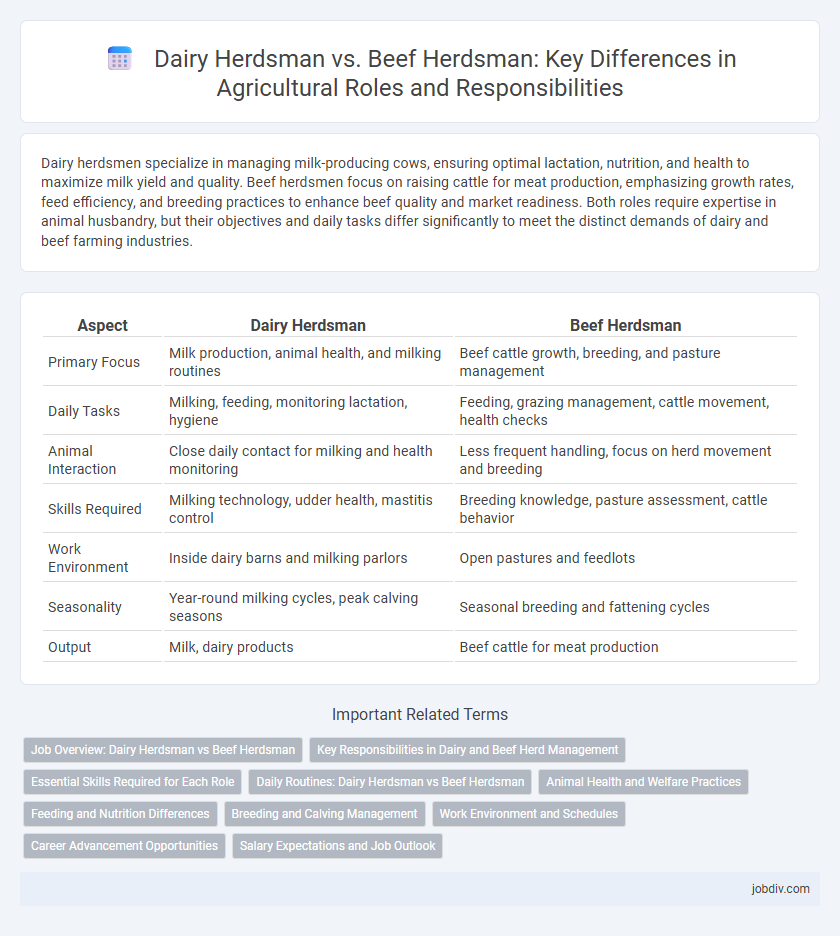Dairy herdsmen specialize in managing milk-producing cows, ensuring optimal lactation, nutrition, and health to maximize milk yield and quality. Beef herdsmen focus on raising cattle for meat production, emphasizing growth rates, feed efficiency, and breeding practices to enhance beef quality and market readiness. Both roles require expertise in animal husbandry, but their objectives and daily tasks differ significantly to meet the distinct demands of dairy and beef farming industries.
Table of Comparison
| Aspect | Dairy Herdsman | Beef Herdsman |
|---|---|---|
| Primary Focus | Milk production, animal health, and milking routines | Beef cattle growth, breeding, and pasture management |
| Daily Tasks | Milking, feeding, monitoring lactation, hygiene | Feeding, grazing management, cattle movement, health checks |
| Animal Interaction | Close daily contact for milking and health monitoring | Less frequent handling, focus on herd movement and breeding |
| Skills Required | Milking technology, udder health, mastitis control | Breeding knowledge, pasture assessment, cattle behavior |
| Work Environment | Inside dairy barns and milking parlors | Open pastures and feedlots |
| Seasonality | Year-round milking cycles, peak calving seasons | Seasonal breeding and fattening cycles |
| Output | Milk, dairy products | Beef cattle for meat production |
Job Overview: Dairy Herdsman vs Beef Herdsman
Dairy herdsmen specialize in managing milking cows, overseeing daily milking routines, maintaining hygiene, and ensuring optimal milk production. Beef herdsmen focus on breeding, raising, and caring for cattle primarily raised for meat, monitoring grazing patterns, and managing pasture health. Both roles require animal health knowledge and farm equipment handling but differ in production goals and daily tasks.
Key Responsibilities in Dairy and Beef Herd Management
Dairy herdsmen focus on managing lactation cycles, ensuring milking hygiene, monitoring milk yield, and maintaining cow health to optimize dairy production. Beef herdsmen prioritize breeding, grazing management, and the overall growth and fattening of cattle for meat quality. Both roles require close observation of animal health and feeding practices but differ significantly in daily tasks and production goals.
Essential Skills Required for Each Role
Dairy herdsmen require expertise in milking procedures, animal nutrition, and maintaining hygiene standards to ensure high-quality milk production and herd health. Beef herdsmen focus on skills such as pasture management, breeding selection, and livestock handling to optimize weight gain and meat quality. Both roles demand strong observation abilities, animal health knowledge, and effective record-keeping to monitor herd performance and welfare.
Daily Routines: Dairy Herdsman vs Beef Herdsman
Dairy herdsmen manage daily milking schedules, ensuring cows are milked two to three times a day while monitoring udder health and milk quality. Beef herdsmen focus on grazing management, feeding, and health checks to promote weight gain and breeding efficiency. Both roles require regular observation, but dairy herdsmen engage more in milking procedures, whereas beef herdsmen emphasize pasture management and animal growth.
Animal Health and Welfare Practices
Dairy herdsmen prioritize meticulous monitoring of milk-producing cows, ensuring optimal udder health, proper nutrition, and stress reduction to maximize milk yield and quality. Beef herdsmen emphasize natural grazing patterns, disease prevention through vaccinations, and maintaining proper body condition to promote growth and meat quality. Both roles implement biosecurity measures and regular health assessments, tailored to their livestock's specific needs and production goals.
Feeding and Nutrition Differences
Dairy herdsmen prioritize high-energy and protein-rich diets to maximize milk production, incorporating balanced rations of silage, grains, and supplements to support lactation. Beef herdsmen focus on forage-based nutrition with emphasis on growth and muscle development, often integrating pasture grazing and energy-dense feed to optimize weight gain. Nutritional management in dairy herds requires precise monitoring of mineral balance and rumen health, whereas beef nutrition centers on efficient feed conversion and maintaining body condition for market readiness.
Breeding and Calving Management
Dairy herdsmen concentrate on selective breeding techniques to improve milk yield, focusing on genetic traits like udder health and lactation efficiency. Calving management in dairy herds involves closely monitoring cows for signs of labor to ensure timely assistance and reduce calf mortality rates. Beef herdsmen prioritize breeding for traits such as growth rate and carcass quality, implementing rotational breeding systems to maintain herd genetics and enhance beef production.
Work Environment and Schedules
Dairy herdsmen typically work in controlled environments such as barns or milking parlors with early morning and late evening shifts to manage milking schedules, requiring consistent daily routines and strict hygiene standards. Beef herdsmen operate mostly outdoors on pastures or ranches, facing variable weather conditions with more flexible but physically demanding schedules centered around feeding, breeding, and health monitoring. The contrasting work environments influence their daily responsibilities, with dairy herdsmen focused on milking precision and beef herdsmen prioritizing livestock grazing management and animal welfare.
Career Advancement Opportunities
Dairy herdsmen typically have more structured career advancement opportunities through specialized skills in milking technologies, herd health management, and dairy nutrition, which are critical for large-scale dairy operations. Beef herdsmen often advance by gaining expertise in pasture management, breeding programs, and meat quality optimization, leading to roles in ranch management or livestock consultancy. Both career paths benefit from certifications and experience, but the dairy sector tends to offer more predictable progression due to its intensive production systems and market demands.
Salary Expectations and Job Outlook
Dairy herdsmen typically earn an average salary ranging from $30,000 to $45,000 annually, reflecting the specialized skills required for managing milking routines and animal health in dairy operations. Beef herdsmen salaries often vary between $28,000 and $42,000, influenced by the scale of ranching and livestock management expertise. Job outlook for both roles shows steady demand due to ongoing livestock production needs, with dairy herdsmen experiencing slightly higher growth prospects linked to expanding dairy markets and technological advancements in milk production.
Dairy Herdsman vs Beef Herdsman Infographic

 jobdiv.com
jobdiv.com